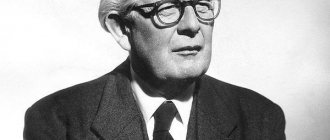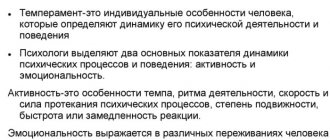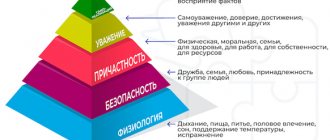Eight stages of personality development according to Erik Erikson. Theory of psychosocial development.
According to psychologist Erik Erikson, all people in their development go through eight crises , or conflicts.
Model of personality development.
Erikson developed a model of personality development that covers the entire period of human life. The main concept of his theory is “ego identity” or, in other words, the integrity of the individual. The formation of ego identity continues throughout a person’s life and goes through a number of stages.
Erikson identified 8 stages of personality development from birth to death.
| Age | Stage name |
| 0-1 | Trust or mistrust. |
| 2 — 3 | Independence or indecisiveness |
| 4 — 5 | Entrepreneurship or guilt |
| 6 — 11 | Skill or inferiority |
| 12 — 19 | Identity or role confusion |
| 20 — 25 | Early maturity. Intimacy or isolation |
| 26 — 64 | Average maturity. Productivity or inertia |
| From 65 years old | Late maturity. Integration or despair |
Stage 1.
Trust or distrust (0-1 year).
trust vs. mistrust
This stage covers the first year of life. At this stage, the sensory systems mature. That is, vision, hearing, smell, taste, and tactile sensitivity develop. A person is thirsty for new experiences, he masters the world .
At this stage, as at all subsequent ones, there are two paths of development: positive and negative.
| Positive way | Negative way |
| The child gets everything he wants. All the child’s needs are quickly met. As a result, the world is a cozy place where people can be trusted. The result of a positive path: The child develops the ability to form warm, deep, emotional relationships with other people, and optimism. If a small child could speak, he would say: “I am loved,” “I feel cared for, reliable.” | The mother’s focus is not on the child, but on caring for him or educational measures, or her own career, disagreements with relatives, anxieties of various kinds, etc. The result of the negative path: Distrust, suspicion, fear of the world and people, and pessimism are formed. |
Stage 1 Summary: oral-sensory. Psychosocial crisis: Basic trust – basic mistrust. Originally Answered: Can I trust the world? The strength is hope.
Up
Stage 2.
Independence or shame and indecisiveness (2-3 years)
autonomy vs. shame and doubt
This stage covers the second and third years of life. The second stage of personality development, according to E. Erikson, consists of the child forming and defending his autonomy and independence . It begins from the moment the child begins to walk . At this stage, the child masters various movements, learns not only to walk, but also to climb, open and close, hold on, throw, push, etc. Children enjoy and are proud of their new abilities and strive to do everything themselves .
| Positive way | Negative way |
| Parents give the child the opportunity to do what he is able to do, do not limit his activity, and encourage the child. At the same time, parents should unobtrusively but clearly limit the child in those areas of life that are dangerous for the children themselves and others. The child does not receive freedom, his freedom is limited. The result of a positive path: the child gains independence; autonomy; a feeling is developed that he controls his body, his aspirations, and to a large extent controls his environment; the foundations of free self-expression and cooperation are laid; self-control skills are developed without compromising one’s self-esteem; will. “Mom, look how great it is. I own my body. I can control myself." | Parents limit the child’s actions, parents are impatient, they rush to do for the child what he himself is capable of, parents shame the child for accidental offenses (broken cups); or vice versa, when parents expect their children to do something that they themselves are not yet able to do. The result of the negative path: the child develops indecision and lack of confidence in his abilities; doubt; dependence on others; a feeling of shame in front of others is consolidated; the foundations are laid for constrained behavior, low sociability, and constant vigilance. “My body is bad and I myself am bad”, “I have to control everything I do very carefully.” “I want to be independent, but I’m afraid that I won’t succeed.” |
Stage 2 Summary: Muscular-anal. Psychosocial crisis: Independence – shame and doubt. Originally Answered: Can I control my body? Strength is willpower.
Up
Stage 3.
3. Initiative or guilt (4-5 years).
initiative vs. guilt
Other translation options: enterprise and inadequacy.
Children aged 4-5 years transfer their research activity beyond their own bodies. They try to become independent and explore their limits. They learn how the world works and how they can influence it. The world for them consists of both real and imaginary people and things.
Positive path of development:
If children's exploration activities are generally effective, they learn to deal with people and things in a constructive way and gain a strong sense of initiative .
Parents, encouraging the child’s energetic and independent endeavors, recognizing his rights to curiosity and imagination, contribute to the development of initiative , expanding the boundaries of independence , and the development of creative abilities .
Negative path of development.
Close adults who severely limit freedom of choice, overly control and punish children, cause them to feel too much guilt . Children overwhelmed by guilt are passive , constrained and have little ability for productive work in the future.
Phrases from parents: “You can’t, you’re still small,” “Don’t touch!”, “Don’t you dare!”, “Don’t meddle where you shouldn’t!”, “You won’t succeed anyway, let me do it myself,” “Look, how upset your mother was with you"
Stage 3 Summary: Locomotor-genital, age 3-6 years. Psychosocial crisis: Initiative - guilt. Originally Answered: Can I become independent from my parents?
?
Strength is purpose.
Up
Stage 4.
Hard work or feelings of inferiority (6-11 years).
industry vs. inferiority
Between the ages of 6 and 11, children develop numerous skills and abilities at school, at home and among their peers.
According to Erikson's theory, the sense of self is greatly enriched as the child's competence in various areas increases
The child asks himself the question: Am I capable?
Positive way:
When children are encouraged to do what they love, learn new skills (tinkering, cooking, doing handicrafts, even if they are not so good and neat), when they are allowed to finish what they started, praised and rewarded for their results, then the child develops skill and ability for technical creativity.
Negative way:
Parents who see their children’s work as mere “pampering” and “messing up” contribute to the development of their feelings of inferiority.
A child's sense of competence and work ethic are also highly dependent on school performance. If a student learns educational material more slowly than his peers and cannot compete with them, then continuously falling behind in class develops a sense of inferiority in him.
Comparing oneself with one's peers is becoming increasingly important . During this period, negative assessment of oneself in comparison with others causes especially great harm.
Stage 4 Summary: Latent, age 6-11 years. Psychosocial crisis: hard work-inferiority. Answer to the question: Am I capable? Strengths: competence, confidence.
Up
Stage 5.
5.Identity or role confusion (12-19 years old).
identity vs. role confusion
Before adolescence, children learn a number of different roles - student or friend, older sibling, sports or music student, etc. During adolescence and adolescence, it is important to understand these different roles and integrate them into one coherent identity.
A teenager is looking for confidence, security, trying to be like other teenagers in his age group. He develops stereotypical behavior and ideals and often joins various groups or clans . Peer groups are very important for rebuilding self-identity. This is the second major attempt at developing autonomy (after stage 2), and it requires challenging parental and social norms .
Negative path of development: Boys and girls seek basic values and attitudes that cover all these roles. If they fail to integrate a core identity or resolve a major conflict between two important roles with opposing value systems, the result is what Erikson calls identity diffusion .
The teenager becomes distrustful, shy, insecure, filled with guilt and consciousness of his inferiority.
Stage 5 Summary: Adolescence, age 12-19 years. Psychosocial crisis: Self-identity - role confusion. Answer to the question: Who am I? Strength is loyalty.
Up
Stage 6.
6. Intimacy or isolation (20-25 years).
intimacy vs. isolation
In late adolescence and early adulthood, a central developmental tension is the conflict between intimacy and isolation. In Erickson's description, intimacy includes more than sexual intimacy. It is the same as the intimate feeling we have for spouses, friends, siblings, parents or other relatives.
This is the ability to give a part of yourself to another person of any gender, without fear of losing your own identity . Success in establishing this type of close relationship depends on how the five previous conflicts were resolved.
- For example, a person who has difficulty trusting others (stage 1) will have difficulty loving ;
- A person who needs to control himself (stage 3) will find it difficult to allow others to cross his boundary .
- Someone who feels inadequate will find it difficult to be intimate with others.
- And if a person is not sure of his identity (stage 5), then it will be difficult for him to share with others who he is .
Negative path of development.
The inability to establish calm, trusting personal relationships and/or excessive self-absorption leads to feelings of loneliness, social vacuum and isolation.
Read the articles: What is the reason for your loneliness. and 8 types of single (free) women.
Self-absorbed people may engage in very formal personal interactions and make superficial contacts, without showing real involvement in the relationship, because the increased demands and risks associated with intimacy pose a threat to them.
Stage 6 Summary: Early maturity, age 20-25 years. Psychosocial crisis: Intimacy-isolation. Originally Answered: Can I have an intimate relationship? The strong point is love.
Up
Stage 7.
Generativeness or stagnation (26-64 years).
generativity vs. stagnation
In adulthood, after previous conflicts have been partially resolved, men and women can pay more attention to and help other people. Parents sometimes find themselves helping their children. But not only. Productivity appears as the concern of the older generation about those who will replace them - about how to help them gain a foothold in life and choose the right direction.
Some people can direct their energy to solving social problems without conflict. But failure to resolve previous conflicts often leads to excessive self-absorption : one’s health, the desire to satisfy one’s psychological needs, to preserve one’s peace, etc.
Stage 7 Summary: Middle maturity, age 26-64 years. Psychosocial crisis: productivity-stagnation. Originally Answered: What am I going to do with the rest of my life? The strength is caring.
Up
Stage 8.
Ego integrity or despair (over 65 years old).
ego integrity vs. despair
In the last stages of life, people usually reconsider the life they have lived and evaluate it in a new way.
If a person’s life was filled with meaning and active participation in events, then he comes to the conclusion that he did not live in vain and fully realized what fate had given him.
Then he accepts his life entirely , as it is. But if life seems to him a waste of energy and a series of missed opportunities, he begins to feel despair.
It is obvious that one or another resolution of this last conflict in a person’s life depends on the cumulative experience accumulated in the course of resolving all previous conflicts.
8Summary: Stage 8. Late maturity, age from 65 years. Psychosocial crisis: Integrity I am despair. Originally Answered: Did my life have meaning? Strength: Wisdom.
Up
Erik Erikson - (eng. Erik Homburger Erikson; 1902, Frankfurt am Main - 1994, Massachusetts) - developmental psychologist and psychoanalyst.
Erikson contrasted Freud's theory, which divided psychological development into five stages, with his own scheme, in which there were eight such stages.
Erickson renamed the so-called “genital stage” “adolescence” and also added three more adult stages (6,7,8).
Erikson also owns the concept of “ego psychology,” emphasizing the role of the Ego as something more than the “handmaiden of the Id” (in Freudian ideas). It is the Ego that is responsible for organizing life, for ensuring harmony with the physical and social environment, for healthy personal growth; it is a source of self-confidence and personal identity.
Winner of the Pulitzer Prize for Nonfiction for his book Gandhi's Truth.
Share link:
- Click here to share content on Facebook. (Opens in a new window)
- Click to share on WhatsApp (Opens in new window)
Similar
What is ego integration?
The feeling of ego integration represents a sense of the integrity of one's self. Children under 3 years of age do not have their own “I”; they identify themselves with the world around them.
When a person feels comfortable in the world, when the world becomes a place to satisfy all human needs, this is integration. That is, integration is the highest degree of fitness.
According to E. Erikson’s epigenetic theory of personality development, ego integration manifests itself in old age, provided that a person has learned from his own experience moments of joy and the bitterness of defeat, and has inspired others. Such a person is not afraid of death, because she managed to leave a mark behind herself (in creative achievements or her descendants), thereby gaining immortality.
Ego identity
Ego Identity
Erikson emphasized the development of ego identity. Ego identity is the conscious sense of self that a person develops through social interaction, and it becomes the “center” of the psychosocial developmental stage of personality identification and role confusion
According to Erikson, a person's ego identity is constantly changing due to new experiences and information that people gain through daily interactions with others. Personal identity provides an integrated and coherent sense of self that persists throughout a person's life. A sense of personal identity is formed through life experiences and interactions with others, and this identity helps a person guide actions, beliefs, and behavior as they age.
Epigenesis
Epigenesis is the theory that each person develops through a sequence of stages that occur in a natural, predetermined order. The stages are sequential, but they are not hierarchical. At each stage, a person is faced with a crisis or problem that is especially important at that time in life and must be resolved
A person's social environment has an extremely important influence on how each crisis is resolved, but it also does not determine the order in which the stages appear.
Erikson's stages, postulated in the epigenetic theory of social development, are associated with a crisis that must be satisfactorily resolved in order for an individual to develop qualities such as trust, autonomy and initiative, etc. While unhealthy or unsatisfactory resolutions lead to mistrust , shame and doubt, guilt, etc., which can make a person psychologically troubled.
Erik Erikson's theory of personality development among other approaches
Erik Erikson
Erikson's theory does not directly seek to achieve learning, developmental, and pedagogical goals; the concept describes the current situation as the norm and highlights undesirable paths of development. This theory can be considered as a guide for psychotherapeutic activities, and not at all for professionals in personality formation.
Direction in psychology
Erik Erikson's seminal work is Childhood and Society (1950). This book draws heavily on the practice of psychoanalysis. Since psychoanalysis has always been aimed at studying mental disorders, the book describes various conflict situations as examples. This work is about childhood and historical processes.
Erikson's theory largely deals with the development of the ego (self). However, the scientist stated that his theories are a continuation of the psychosexual ideas of S. Freud, and they will help in further psychosocial development and in conducting research in the field of biology and sociology.
The psychologist introduced the concept of “ego psychology,” which revealed the role of the Ego in a person’s life. The scientist believed that only the Ego is responsible for the quality of life, for physical and spiritual harmony, for the healthy socialization of a person.
As Erikson stated, the ego determines a person's identity and self-esteem. The inner human “I” is the source of all victories and defeats, joy and sorrow.
It was extremely important for the psychologist to study the Ego and its adaptive abilities when various emotions arise: apathy, fear, aggression. Due to the development of various disorders and crises of a psychological nature in humans, the scientist searched for and selected psychological methods that could effectively help the patient
For example, consultations with a psychologist, therapy, medications, hypnosis
Due to the development of various disorders and crises of a psychological nature in a person, the scientist searched for and selected psychological methods that could effectively help the patient. For example, consultations with a psychologist, therapy, medications, hypnosis.
We recommend: Identification is
Erikson described the main 8 age stages of personality formation, and this became a significant contribution to the study of the human psyche. This teaching is familiar to any professional psychologist.
The scientist tried to demonstrate the influence of culture that it has on the stages of the formation of an individual, and this served as a fulcrum for many researchers studying personality behavior patterns, creating original methods for studying psychological questions that people ask today.
The scientist invented his own concept of psychological development of the individual and divided it into eight stages, somewhat similar to Freud’s diagram of the development of the individual. Erickson only added three new stages of formation.
Erikson wrote that all manifestations must be recognized within the framework of the interrelationship of biology, behavior, perception and society.
The theoretical orientation of Erikson's teachings includes:
- Analysis of the changes that accompany a person throughout his life, starting from childhood.
- Emphasis on the healthy mental state of people, rather than on the pathological one.
- The study of the Ego, which determines a person’s self-identity and individuality.
- Relating clinical findings to cultural and historical phenomena.
- Interpretation of the stages of development and formation of the human psyche.
- Creating methods to help other scientists and psychologists.
Youth
The sixth psychosocial stage lasts from 20 to 25 years and marks the formal beginning of adulthood. In general, this is the period of acquiring a profession, courtship, early marriage, and the beginning of an independent family life.
Intimacy (achieving closeness) - as maintaining reciprocity in a relationship, merging with the identity of another person without fear of losing oneself.
The ability to be involved in a loving relationship includes all of the previous developmental tasks:
- a person who does not trust others will find it difficult to trust himself;
- in case of doubt and uncertainty, it will be difficult to allow others to cross your boundaries;
- a person who feels inadequate will have difficulty getting close to others and taking initiative;
- a lack of hard work will lead to inertia in relationships, and a lack of understanding of one’s place in society will lead to mental discord.
The capacity for intimacy is perfected when a person is able to build intimate partnerships, even if they require significant sacrifices and compromises.
The ability to trust and love another, to derive satisfaction from mature sexual experiences, to seek compromises in common goals - all this indicates satisfactory development during the youth stage.
The positive quality that is associated with a normal way out of the “intimacy/isolation” crisis is love. Erikson emphasizes the importance of the romantic, erotic, and sexual components, but views true love and intimacy more broadly as the ability to commit oneself to another person and remain faithful to this relationship, even if it requires concessions or self-denial, the willingness to share all difficulties together. This type of love manifests itself in a relationship of mutual care, respect and responsibility for the other person.
The danger of this stage is avoidance of situations and contacts that lead to intimacy.
Avoiding the experience of intimacy for fear of “losing independence” leads to self-isolation. The inability to establish calm and trusting personal relationships leads to feelings of loneliness, social vacuum and isolation.
Question answered: Can I have intimate relationships?
Childhood and early years
Erik Erikson was born in Frankfurt, Germany, into the family of Carla Abrahamsen and Jewish stockbroker Waldemar Isidor Salomonsen. At the time the boy was born, his parents had not seen each other for several months. He was recorded as Erik Salomonsen, but there is no real information about his biological father. Soon after the birth of her son, his mother moved to Karlsruhe, where she got a job as a nurse and married a second time, to pediatrician Theodor Homburger.
In 1911, Homburger officially adopted the boy, and he became Eric Homburger. The story of his birth is carefully hidden from him, and the boy grows up not knowing who his real father is.
Preschool or play age (3-6 years)
Children begin to interact more actively and consciously with peers and become interested in various work activities. The social world requires the child to develop new skills and solve new problems for the child.
At this stage, the child’s initiative is formed. Parents should encourage the child’s independent endeavors and should give him the opportunity to show imagination, curiosity and creativity.
Overprotection and too strict boundaries limit the child’s field of imagination, and also create a feeling of guilt in him. Children in such a situation become passive and constrained.
Erikson proposes periodization in the form of a table. What table is this?
- Period designation;
- Designation of the social group that puts forward development tasks and in which a person improves (or you can also see a variant of the formulation “radius of significant relationships”);
- The task of development or that psychosocial crisis in which a person faces a choice;
- As a result of going through this crisis, he acquires either strong personality traits or, accordingly, weak ones. Note that as a psychotherapist, Erickson can never be judgmental. He never talks about human qualities in the format of good and bad.
Personal qualities cannot be good or bad. But he calls strong qualities those that help a person solve development problems. He will call weak those who interfere. If a person has acquired weak personality traits, it is more difficult for him to make the next choice. But he never says that this is impossible. It's just more difficult.
Traits acquired through conflict resolution are called virtues (“virtues”).
The names of the virtues in order of their gradual acquisition are: hope, will, purpose, confidence, loyalty, love, caring and wisdom.
Although Erikson tied his theory to chronological age, each stage depends not only on age-related changes in a person, but also on social factors: studying at school and college, having children, retirement, etc.
| № | Stage | Age | A crisis | Strength |
| 1 | Oral-sensory (infancy) | up to 1 year | Basal trust – basal distrust | Hope |
| 2 | Musculo-anal (early childhood) | 1-3 years | Autonomy – shame and doubt | Strength of will |
| 3 | Locomotor-genital (preschool age) | 3-6 years | Initiative - guilt | Target |
| 4 | Latent (school age) | 6-12 years | Hard work is inferiority | Competence |
| 5 | Adolescence (youth) | 12-20 years | Ego identity - role confusion | Loyalty |
| 6 | Early adulthood (youth) | 20-25 years | Intimacy - isolation | Love |
| 7 | Middle maturity (maturity) | 26-64 years | Productivity is stagnant | Care |
| 8 | Late maturity (old age) | 60-65 – death | Ego integration - despair | Wisdom |
Mature (25-65 years old)
An important point of this stage is creative implementation. In adulthood, a person needs to make a choice between generativity and stagnation, between productivity and inertia.
During this stage, a person focuses on career and family. Successful completion of this stage brings the individual the feeling that he is realizing his own potential and making his feasible contribution to the development of the world.
But many people experience a feeling of meaninglessness, hopelessness and disappointment - a midlife crisis.
Important questions at this stage are:
- What is the significance of my life today? What have I achieved? What can I be proud of?
- How should I spend the rest of my life? What should I do and what can I do?
At the stage of maturity, care is formed, not only about the family, but also care towards oneself. There is no need to devalue your achievements and belittle yourself.











